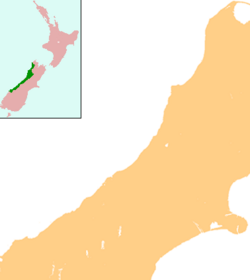Lyell, New Zealand facts for kids
Quick facts for kids
Lyell
|
|
|---|---|

Lyell in circa 1910
|
|
| Country | New Zealand |
| Region | West Coast |
| District | Buller District |
| Electorates | West Coast-Tasman Te Tai Tonga |
| Population
(2006)
|
|
| • Total | 0 |
Lyell is the site of a historic gold mining town. It is located in the Buller Gorge on the South Island of New Zealand. Lyell lies about 18 kilometers northeast of Inangahua on State Highway 6. Today, it is a quiet ghost town and a popular campsite.
Contents
Lyell: A Historic Gold Mining Town
How Lyell Got Its Name
The geologist Julius von Haast named Lyell. He named it after the British geologist Charles Lyell. Charles Lyell was a friend of Sir George Grey. Lyell's writings also influenced Charles Darwin.
The Gold Rush Begins
The gold rush in Lyell started in 1862. Māori prospectors first found gold in Lyell Creek. This creek flows into the Buller River.
Later, in 1869, two Italian miners found more gold. Antonio Zala and Giorgio Zanetti discovered gold in quartz veins. These veins were also in the Lyell Creek area. Miners worked this quartz reef from 1872 until 1912. Gold from quartz reefs was only successfully mined in two places on the West Coast: Lyell and Reefton.
Life in a Busy Gold Town
The settlement of Lyell grew very quickly. By 1863, about 100 people lived there. This was despite the area being hard to reach. It was also difficult to work and often flooded.
In the 1870s, Lyell had a main street called Cliff Street. This street had banks, newspaper offices, and hotels. The town's population grew to over 2000 people in the late 1880s. By 1901, the population was 90. About 40 children attended the local school. In 1905, a company called Alpine Extended Gold Mining Co Ltd still employed 60 people.
Local newspapers were printed when the town was busy. These included the Lyell Argus and Matakitaki Advertiser (1873-1882). Another was the Lyell Times and Central Buller Gazette (1881-1898). A fire in 1896 destroyed the newspaper office and other buildings on Cliff Street.
One famous miner who worked in Lyell was Bridget Goodwin. She was an Irish woman known as Biddy. She worked there in the 1880s and 1890s. Some Italian miners later became dairy farmers in the Lyell area.
Lyell Today
A small settlement continued at Lyell until the 1960s. Today, the ghost town is a campsite. The Department of Conservation looks after it. None of the original buildings are left.
However, a track from the campsite leads to a cemetery. You can also see an old stamping battery. A dray road was built during the gold rush. This road went towards the Lyell Saddle. Now, it is the start of the Old Ghost Road. This is a mountain biking and walking trail. It is 85 kilometers long and ends at Seddonville.



